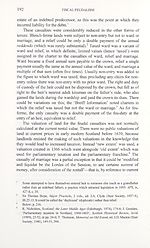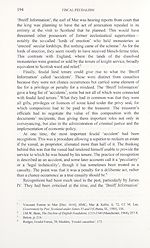Series 5 > Miscellany [of the Scottish History Society] XIII
(208) Page 193
Download files
Complete book:
Individual page:
Thumbnail gallery: Grid view | List view

MISCELLANY XIII
193
values.1 The ‘BreifF Information’ advised that ‘the thesaurer aucht to
considder the fertilitie of the ground’, which sounds as if current values
were being taken into consideration in negotiating compositions. More
specifically it said that while non-entry was normally valued by the
‘retour dewatie’ (the valuation by new extent), the lords of session could
issue a declarator entitling the superior to the full ‘maillis and dewaties’
(the actual rents).2
This concludes the list of casualties arising from the tenures of ward
and relief, blench-ferme, taxed ward and feu-ferme. Two further forms of
tenure should be mentioned briefly. Firstly, within royal burghs there
existed burgage tenure, which was theoretically direct from the crown.
However, the administrative autonomy of the burghs had long severed
any relationship between the individual burgess and the royal
administration, and the documents below do not deal with burgage
tenure.3 Secondly, the lands of the church were traditionally held from
the crown by the tenure of free alms, with a reddendo of prayers for
souls. This had been terminated by the act of annexation of 1587,
annexing all ecclesiastical temporalities to the crown.4 The crown, like
the ecclesiastical lords it superseded, had been in the habit of granting
these temporalities out by feu-ferme. This was part of the process by
which feu-ferme tenure came to spread so widely in Scotland. The act of
1587 had been repealed insofar as concerned the bishoprics in 1606. The
royal commissioner to parliament had described this as the ‘brek’ of the
act of annexation, but it was only a partial repeal—it did not touch
monastic and other lands.5 The bishops themselves as feudal vassals of
the crown did not concern the authors of the documents edited here; they
presumably held by a revived tenure of free alms in which no substantive
regular dues were incurred, and there would be no casualties either
because they did not acquire their lands by succession.6 At the time of the
1 Skene, De Verborum Significatione, s.v. maritagium. Cf. Thomas Craig, Jus Feudale, 2
vols., ed. J.A. Clyde (Edinburgh, 1934), 11.21.18, 11.21.28; Clerk & Scrape, Historical
View, 202.
2 Below, p. 219.
3 Craig, Jus Feudale, 11.19.26.
4 APS, hi, 431-7, c. 8.
5 APS, iv, 281-4, c. 3; earl of Montrose to James VI, 7 July 1606, Original Letters
Relating to the Ecclesiastical Affairs of Scotland, 2 vols., ed. D. Laing (Bannatyne Club,
1851), i, 56.
6 Thus the ‘BreifF Information’ remarked that the crown was no longer concerned with
‘those landis that ar haldin Nomine Cane ... becaus for the most they hold of bischopis
and nocht of the king’: below, p. 214.
193
values.1 The ‘BreifF Information’ advised that ‘the thesaurer aucht to
considder the fertilitie of the ground’, which sounds as if current values
were being taken into consideration in negotiating compositions. More
specifically it said that while non-entry was normally valued by the
‘retour dewatie’ (the valuation by new extent), the lords of session could
issue a declarator entitling the superior to the full ‘maillis and dewaties’
(the actual rents).2
This concludes the list of casualties arising from the tenures of ward
and relief, blench-ferme, taxed ward and feu-ferme. Two further forms of
tenure should be mentioned briefly. Firstly, within royal burghs there
existed burgage tenure, which was theoretically direct from the crown.
However, the administrative autonomy of the burghs had long severed
any relationship between the individual burgess and the royal
administration, and the documents below do not deal with burgage
tenure.3 Secondly, the lands of the church were traditionally held from
the crown by the tenure of free alms, with a reddendo of prayers for
souls. This had been terminated by the act of annexation of 1587,
annexing all ecclesiastical temporalities to the crown.4 The crown, like
the ecclesiastical lords it superseded, had been in the habit of granting
these temporalities out by feu-ferme. This was part of the process by
which feu-ferme tenure came to spread so widely in Scotland. The act of
1587 had been repealed insofar as concerned the bishoprics in 1606. The
royal commissioner to parliament had described this as the ‘brek’ of the
act of annexation, but it was only a partial repeal—it did not touch
monastic and other lands.5 The bishops themselves as feudal vassals of
the crown did not concern the authors of the documents edited here; they
presumably held by a revived tenure of free alms in which no substantive
regular dues were incurred, and there would be no casualties either
because they did not acquire their lands by succession.6 At the time of the
1 Skene, De Verborum Significatione, s.v. maritagium. Cf. Thomas Craig, Jus Feudale, 2
vols., ed. J.A. Clyde (Edinburgh, 1934), 11.21.18, 11.21.28; Clerk & Scrape, Historical
View, 202.
2 Below, p. 219.
3 Craig, Jus Feudale, 11.19.26.
4 APS, hi, 431-7, c. 8.
5 APS, iv, 281-4, c. 3; earl of Montrose to James VI, 7 July 1606, Original Letters
Relating to the Ecclesiastical Affairs of Scotland, 2 vols., ed. D. Laing (Bannatyne Club,
1851), i, 56.
6 Thus the ‘BreifF Information’ remarked that the crown was no longer concerned with
‘those landis that ar haldin Nomine Cane ... becaus for the most they hold of bischopis
and nocht of the king’: below, p. 214.
Set display mode to:
![]() Universal Viewer |
Universal Viewer | ![]() Mirador |
Large image | Transcription
Mirador |
Large image | Transcription
Images and transcriptions on this page, including medium image downloads, may be used under the Creative Commons Attribution 4.0 International Licence unless otherwise stated. ![]()
| Scottish History Society volumes > Series 5 > Miscellany [of the Scottish History Society] XIII > (208) Page 193 |
|---|
| Permanent URL | https://digital.nls.uk/127316025 |
|---|
| Description | Over 180 volumes, published by the Scottish History Society, containing original sources on Scotland's history and people. With a wide range of subjects, the books collectively cover all periods from the 12th to 20th centuries, and reflect changing trends in Scottish history. Sources are accompanied by scholarly interpretation, references and bibliographies. Volumes are usually published annually, and more digitised volumes will be added as they become available. |
|---|


